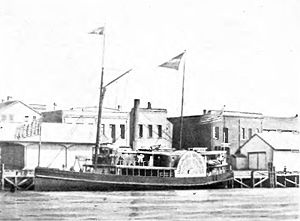PS Eliza Anderson

Eliza Anderson
|
|
| History | |
|---|---|
| Name: | Eliza Anderson |
| Route: | Puget Sound, Strait of Georgia, Fraser River, Admiralty Inlet, Strait of Juan de Fuca, Alaska, Columbia River, |
| Builder: | Samuel Farman’s yard, foot of Couch Street, Portland, Oregon |
| Laid down: | Early 1857 |
| Launched: | November 27, 1858 |
| Maiden voyage: | January 2, 1859 |
| In service: | 1859-1898 (with significant intermediate periods out of service) |
| Out of service: | various times, finally beached and abandoned 1898 at Dutch Harbor |
| Fate: | Abandoned 1898, Dutch Harbor, Alaska |
| General characteristics | |
| Type: | inland steamship |
| Tonnage: | 276 |
| Length: | 140 ft (43 m) |
| Beam: | 25.5 ft (8 m) |
| Depth: | 8.8 ft (3 m) depth of hold |
| Decks: | three (freight, passenger, boat) |
| Installed power: | low-pressure boiler, single-cylinder walking beam steam engine |
| Propulsion: | sidewheels |
| Sail plan: | schooner (auxiliary) |
The PS Eliza Anderson operated from 1858 to 1898 mainly on Puget Sound, the Strait of Georgia, and the Fraser River but also for short periods in Alaska. She was generally known as the Old Anderson and was considered slow and underpowered even for the time. Even so, it was said of her that “no steamboat ever went slower and made money faster.” She played a role in the Underground Railroad and had a desperate last voyage to Alaska as part of the Klondike Gold Rush.
Eliza Anderson was launched on November 27, 1858, at Portland, Oregon for the Columbia River Steam Navigation Company. She was a sidewheeler driven by a low pressure boiler generating steam for a single cylinder walking-beam steam engine She was built entirely of wood, measuring 197' long, 25.5 feet on the beam, and rated at 276 tons capacity.
After her trial run on the lower Willamette and Columbia rivers, she was sold to a consortium of John T. Bradford, some Canadian stockholders and three brothers, Tom, John T. and George S. Wright, who were early steamboat operators in the Pacific Northwest. Under Capt. J.G. Hustler, she was brought around to Victoria, arriving in March 1859. Because of the Fraser River Gold Rush, there was a shortage of steamboats in British Columbia in 1858-1859. This had a number of effects on the Canadian west coast, perhaps the most important of which was the establishment of British Columbia as a separate colony from Vancouver Island. For the American steamboats, they benefitted by decision of Canadian governor James Douglas to grant “sufferances” to them to allow them to work on the Victoria to Fraser River route at a levy of $12 per run.
...
Wikipedia
